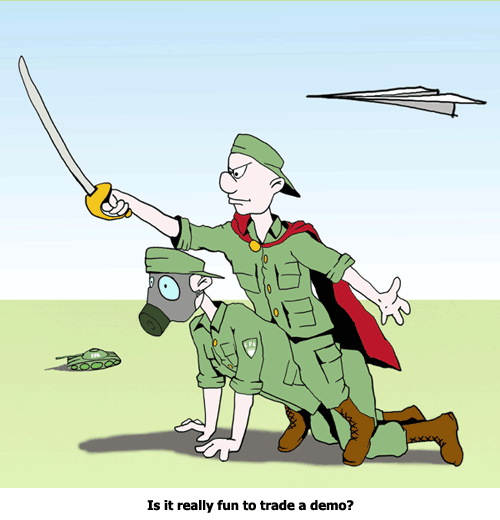Part VI. The time has come to talk about DEMO

Commander in Pips: So, we’ve studied a lot of stuff. Now you know how to read quotes, open and close positions, calculate profit and loss, margin requirements and even how place orders. But it’s too early to start with real money trading still.
Pipruit: Why not? I think that I can independently open trades, I understand all information, know how to place orders, as you say
Commander in Pips: Let me just single stupid question – and when and where you will open these positions, that you’ve talking about? And generally speaking – you do not have a profitable system of trading.
Pipruit: Oh, I didn’t think about that yet. So what should I do know?
Commander in Pips: Don’t worry, son. We will definitely create a good trading system as we will move through our school. But today, I want to tell you about using Demo accounts. My thought about demo is that it is a must.

1. Demo trading is free. As we discussed previously, the FX brokerage and dealing service market is very competitive. FX Brokers and Dealers struggle against each other for customers, so demo accounts have become an additional free service a long time ago. But why do brokers and dealers provide these accounts for free? It isn't a secret. Most traders use demo not just for testing the trading software itself, but for trading training. So the longer you use a particular demo software, the greater the probability is that you will open a real account with this broker. Because you will become accustomed to the trading platform and the broker the longer you use it. Providing demo accounts for free from brokers and dealers allows clients investigate all the advantages and disadvantages of trading software, terms and quality of the brokerage services in general. If a broker provides good services and has a good software people will be more likely to open a real account with him. That’s simple.
2. Demo has all qualities of a real account trading. Currently demo trading is real-time with real quotes. In fact, there is only one difference to real trading – all your profits and losses are on paper only. But you trade demo with real market quotes with real margin calculation, swaps, profit and loss and all other things. Demo account is real, except the money isn't real. The only other difference is that a demo account usually has less slippage and requotes than a real account. Hence we come the next quality of demo-
3. A Demo account provides zero risk for you. Do you hear me? You risk nothing – you should not deposit any money or even sign any contracts with broker/dealer. As a rule, all that you will have to do is to register at broker/dealer web site and download its software. That’s all!
Pipruit: Now I understand, why you’ve said that demo trading is a must. I also think the same. But how long I have to sit on a Demo account and how I will recognize that I’m ready to open a real account?
Commander in Pips: You should deal with demo and only with demo until you are able to generate profit stably. Other words, you should trade on demo until you create solid and profitable trading system.
Pipruit: And what does it mean – stably, solid and profitable?
Commander in Pips: We will discuss how to determine the quality of trading system a bit later in our school, but in general, “profitable” means that your system should generate net profit, although it can show losing trades also. “Solid” means that your trading system should generate net profit based on the results of a large number of trades – at least some hundred trades. But this is very general description.
If you consider yourself as rational and clever trader or want to become that sort of trader, then you should promise yourself to not open a real account, until you create such a stable, solid and profitable trading system.
Pipruit: I think that I have no choice just to accept your offer. Besides, otherwise I will definitely lose all of my money.
Commander in Pips: This is a good decision, son. The alternative is to just freely to give your money to some other person. If it’s too hot for you – better step aside.
Pipruit: And in general, how much time should I spend on Demo?
Commander in Pips: TWell, I think about a year in average. Some traders need much more time – some years to come to good trading system.
Pipruit: Such a long time…
Commander in Pips: Well, if this is too difficult to you – trade demo at least for 2-3 months. At least you will probably not lose all of your money so quickly after that.
When you will start demo trading, it is better is to focus on one definite major pair. Dealing with just one pair after some time allows you better understand the dynamic of this pair and it’s reaction on data releases. You will better remember the previous price action and it will be easier to see the large picture. Also it’s simpler to investigate basic major macro data for just one pair.
And the last point – anyone can become a successful trader. In fact, for trading as any other work or duty in life – you need all the same things. These are study, hard work, time dedication, some luck and a lot of common sense.
Pipruit: Thanks Commander, I remember that.
Comments
B
Bulldogger71
7 years ago,
Registered user
What demo does everybody use,how do you take profit and keep trading totally confused
Table of Contents
- Introduction
- FOREX - What is it ?
- Why FOREX?
- The structure of the FOREX market
- Trading sessions
- Where does the money come from in FOREX?
- Different types of market analysis
- Chart types
- Support and Resistance
-
Candlesticks – what are they?
- Part I. Candlesticks – what are they?
- Part II. How to interpret different candlesticks?
- Part III. Simple but fundamental and important patterns
- Part IV. Single Candlestick Patterns
- Part V. Double Deuce – dual candlestick patterns
- Part VI. Triple candlestick patterns
- Part VII - Summary: Japanese Candlesticks and Patterns Sheet
-
Mysterious Fibonacci
- Part I. Mysterious Fibonacci
- Part II. Fibonacci Retracement
- Part III. Advanced talks on Fibonacci Retracement
- Part IV. Sometimes Mr. Fibonacci could fail...really
- Part V. Combination of Fibonacci levels with other lines
- Part VI. Combination of Fibonacci levels with candle patterns
- Part VII. Fibonacci Extensions
- Part VIII. Advanced view on Fibonacci Extensions
- Part IX. Using Fibonacci for placing orders
- Part X. Fibonacci Summary
-
Introduction to Moving Averages
- Part I. Introduction to Moving Averages
- Part II. Simple Moving Average
- Part III. Exponential Moving Average
- Part IV. Which one is better – EMA or SMA?
- Part V. Using Moving Averages. Displaced MA
- Part VI. Trading moving averages crossover
- Part VII. Dynamic support and resistance
- Part VIII. Summary of Moving Averages
-
Bollinger Bands
- Part I. Bollinger Bands
- Part II. Moving Average Convergence Divergence - MACD
- Part III. Parabolic SAR - Stop And Reversal
- Part IV. Stochastic
- Part V. Relative Strength Index
- Part VI. Detrended Oscillator and Momentum Indicator
- Part VII. Average Directional Move Index – ADX
- Part VIII. Indicators: Tightening All Together
- Leading and Lagging Indicators
- Basic chart patterns
- Pivot points – description and calculation
- Elliot Wave Theory
- Intro to Harmonic Patterns
- Divergence Intro
- Harmonic Approach to Recognizing a Trend Day
- Intro to Breakouts and Fakeouts
- Again about Fundamental Analysis
- Cross Pair – What the Beast is That?
- Multiple Time Frame Intro
- Market Sentiment and COT report
- Dealing with the News
- Let's Start with Carry
- Let’s Meet with Dollar Index
- Intermarket Analysis - Commodities
- Trading Plan Framework – Common Thoughts
- A Bit More About Personality
- Mechanical Trading System Intro
- Tracking Your Performance
- Risk Management Framework
- A Bit More About Leverage
- Why Do We Need Stop-Loss Orders?
- Scaling of Position
- Intramarket Correlations
- Some Talk About Brokers
- Forex Scam - Money Managers
- Graduation!